Rose leaf spot
A diseased rose bush is a tragedy for gardeners. The prickly queen of flower beds is susceptible to a variety of infectious and non-infectious diseases, and may suffer from attack by pests.To prevent the death of your pet, you need to determine exactly what infected the plant, and this is a whole puzzle for a summer resident. A common infectious disease of roses is various leaf spots.
| Content:
|
Diseases that cause spots to appear on roses
Diseases of rose leaves reduce the decorative value of bushes and often lead to their death. The causative agents of all types of spotting are fungi, which with their spores infect the succulent leaves and shoots of the bush. Depending on the course of the disease, color, and size of the spots, the following types of infection are distinguished:
- Black spot (marsonina rosea)
- Downy mildew (peronospora)
- Rust on roses
- Septoria and phyllostictosis spotting of roses (septoria, phyllostictosis of leaves).
So what should you do if spots appear on the leaves of your rose? This is exactly what we will talk about in detail now.
Black spot
Even in the spring, the fungus (Marssoninarosae) infects both leaves and young, green shoots. Spores are transferred to the surface of rose leaves mainly by droplets. Their spread is facilitated by watering, rain, fog, and dew. Having infected a bush in early spring, the fungus develops inside the plant for some time without showing itself in any way.
|
This is what black spots on rose leaves look like |
Signs of illness
At the initial stage of the disease, the leaves on top are covered with whitish spots. Over time, they grow and change color, turning into black round spots. Rays radiate from their rims in different directions. In this way, black spotting resembles a scattering of stars in the sky.First, the disease attacks the lower leaves, very quickly taking over the entire bush. The disease appears on the surface in the form of black spots when the spores of the disease have multiplied to such a state that they are ready to begin sporulation. The leaf blade, covered with black spots, gradually turns yellow and falls off.
Unlike downy mildew, infected leaves begin to fall off from the lower branches of the bush, and all shoots gradually become bald.
Black spot treatment
In the early stages of the disease, folk remedies can be called upon to help. When the disease progresses violently, you should turn to fungicides. In both cases, it is impossible to completely destroy the disease; you can only stop its spread. The plant will still be weakened and lose its decorative effect.
- When black spots first appear on the leaves, they should be torn off and destroyed;
- Stop applying any fertilizing;
- Immediately, treat the roses according to the following scheme: spray the plant with the fungicide “Ridomil Gold”, after 10-14 days treat with the drug “Skor”, after 10-14 days repeat the treatment with “Ridomil Gold”;
- As soon as the plant begins to produce fresh leaves, free of black spot, you need to restore the soil microflora by adding microbiological fertilizers to the soil.
Prevention
Strong changes in day and night temperatures, forming dew, are a threat to rose bushes. The first half of the day, the seedlings should be illuminated by the sun, which will dry the dew and prevent the spread of spores. Evening watering, in which the rose goes into the night with wet leaves, also creates an optimal environment for the occurrence and spread of black spot.
To minimize the risk of roses becoming infected with black spot, the rose garden is placed in open, sunny, ventilated flower beds. Light partial shade is allowed in the afternoon.
For prevention, bushes are periodically treated with biofungicides: “Trichopsin”, “Trichodermin”, “Gaupsin”, alternating them and strictly following the instructions.
Downy mildew
The plant's enemy, a fungus, selects leaves and young shoots of the bush for its life. The occurrence and reproduction of the fungus is provoked by high air and soil humidity, thickened plantings, sudden changes in night and day temperatures, and excess nitrogen during fertilizing.
|
Rose leaves affected by downy mildew |
Visually, powdery mildew is often confused with black spot. With downy mildew, infection occurs from the top of the bush, the leaves fall off from the top, and with black spotting, spots first appear on the lower leaves. The plant loses leaves in just a couple of days.
Downy mildew is a perennial disease; the spores of the fungus are tenacious and overwinter in roots, bulbs, and various plant debris.
Signs of illness
The fungus engulfs the crown of the plant and spreads downwards throughout the bush, staining the leaves with a purple border and spots. In the acute phase of the disease, the leaves become soft, the edges curl, they gradually dry out and fall off. Stunted, sickly-looking bushes spoil the overall picture of the flower garden, they lag behind in growth, the set of buds and flowering stops.
Similar to black spot, downy mildew on rose leaves manifests itself in damp summers with prolonged rains.
Treatment of downy mildew
To combat the disease, roses are treated with the following chemicals:
- “Previkur Energy”. Starts working in 30 minutes.after processing the plant. The disease is completely defeated within a day. After diluting 50 ml. drug for 10 l. Spray the plant with water and apply the medicine to the root;
- "Ordan". Treated in the fall, before covering the rose bushes. It has healing properties and minimizes the risk of getting the disease the next year. The composition is prepared by diluting 25 g. for 10 l. water and spray the plants;
- “Kurzat”, “Quadris”. Treat the rose garden with these preparations with the following composition, respectively: 25 gr. for 10 l. water and 5 ml per 10 liters of water.
To prevent the infection from developing stable immunity to fungicides, treatment is carried out not with one drug, but with several, alternating and changing the compositions.
Disease prevention
- The disease primarily affects oppressed, weak bushes. It is necessary to analyze the agricultural technology of growing roses, to find out what exactly the plant lacks. On an annual basis, treat the prickly queen with compost and rotted manure, this will lead to the development of beneficial bacteria;
- Use biofungicides (biological agents against plant diseases): “Fitosporin-M”, “Gamair”, “Alirin-B”. The compositions are prepared according to the instructions, processing is carried out weekly, in the evening hours, alternating products;
- Avoid dense plantings by placing bushes at a sufficient distance from each other. This will ensure ventilation of the roses and eliminate increased humidity and dampness in the plantings;
The spread of the disease is facilitated by pruning rose bushes with a dirty tool. After each use, it must be disinfected.
Rust on roses
|
rice. |
The disease is caused by spores of several types of fungi. An infectious disease with several stages of development, affecting all green above-ground parts of the plant.All three stages are united by the formation of bright powdery accumulations of spores on the underside of the leaves.
- The first stage begins in spring and early summer, when the overwintering mycelium of parasites on the underside of the leaf forms a scattering of small protruding orange spots.
- The second stage of rust development on roses is summer. The yellow-orange spore pads are not just convex, but stick out on stalks and also settle on the underside of leaves.
- The third stage is characterized by dark brown spots. Over time, the color changes to rusty brown. The spots grow on the surface of the leaf and turn black in the fall. The shoots crack and become deformed.
Infected, weakened plants do not overwinter well; if the fungus gets into the root, the entire bush is cut out into a stump. The pathogens overwinter in the form of mycelium, both in damaged pet shoots and in plant debris.
|
This is what powdery rust spores look like on the inside of a leaf. |
Signs of illness
The disease has several stages of development, so it is initially difficult to diagnose a diseased plant. Damaged parts of a rose bush affected by rust are visually similar to plants infected with some other types of blight. This misleads gardeners and makes it difficult to make a correct diagnosis.
The main sign of rust is the presence of yellow powdery accumulations on the inside of leaves.
Having settled on rose bushes, rust will become a permanent resident of the flower garden. It is very difficult to exterminate it. If you miss the disease, in a short time the entire rose garden will be infected, and sick pets will die.
How to treat rust on roses
Long-term practice of experienced rose growers shows that it is possible to cure roses from rust with only two preparations: ‘Falcon’ and ‘Impact Exclusive’. All other fungicides do not have such an active force and are used only as a preventive measure for the occurrence of the disease.
- The bushes should be treated immediately after opening the roses. Starting from mid-May, treat with the drug ‘Falcon’ once a month at a rate of 10 ml. substances per 10 l. water. Spray the rose garden, as well as the entire garden, with this composition throughout the season;
- The most difficult stage in the fight against rust on roses occurs in autumn. Before covering roses for the winter, you need to carefully collect and burn all pink foliage. This is a mandatory procedure in the infection control scheme and should not be ignored. It is on fallen leaves that fungal spores overwinter. Without removing the litter from the site, the fungal spores will overwinter in it without any problems, and in the spring they will immediately make themselves felt.
Don't forget to read:
Prevention
To enjoy a healthy rose garden each season, you need to follow a preventative plan developed by experienced rose growers.
- In early spring, treat the entire rose garden with copper-containing preparations, including the soil under the bushes: ‘Hom’, ‘Oksikhom’, ‘Ordan’;
- In early May, treat roses with the preparation ‘Strobi’ in double concentration. This will lead to the destruction of the mycelium that forms;
- Before winter, treat the plantings a second time with copper-containing preparations: ‘Bordeaux mixture’, ‘Hom’, ‘Oxychom’, ‘Ordan’.
Septoria and phyllostictosis spotting of roses
Diseases of rose leaves, proceeding almost the same way. Plants are infected by fungi “Septoriarosae” and “Phyllostictarosae”. Numerous round spots appear on the top of infected leaves.
|
Septoria rose spot |
Signs of illness
For septoria At first they are dark brown, later the affected tissue in the center becomes lighter and is bordered by a thin brown rim. Weak leaves turn yellow and fall off prematurely.
|
Phyllostictosis of rose leaves |
For phyllostictosis the spots are dark brown or ash-white with a wide purple border. Small black fungal bodies form in the center of the affected areas. As with septoria, infected leaves turn yellow and fall prematurely.
Treatment
Septoria leaf blight of roses causes the Septoriarosae fungus, which is combated with the following fungicides: ‘Topaz’, ‘Bordeaux mixture’, ‘Skor’, ‘Profit Gold’. At intervals of a week, spray the plants and the soil underneath them, alternating the preparations. Before treatment, the bushes are cleaned of affected leaves and shoots.
Phyllostictosis of rose leaves (brown spot). Treatment of sick, weakened bushes affected by this disease is carried out similarly to the fight against septoria of rose leaves. Three times a season they are sprayed with preparations containing triazole: ‘Skor’ and ‘Topaz’. In the acute stage of the disease, turn to the fungicides ‘Abiga-Pik’ and ‘Strobi’ for help. The solutions ‘Ridomil Gold’ and ‘Profit Gold’ will be of great help.
Don't forget to read:
Similar articles:
- Diseases of roses and methods of their treatment ⇒
- Treatment of powdery mildew on roses, what to do if powdery plaque appears on the leaves ⇒
- What to do if the leaves of an indoor rose turn yellow and fall off ⇒
- What to do if cucumber leaves turn yellow ⇒

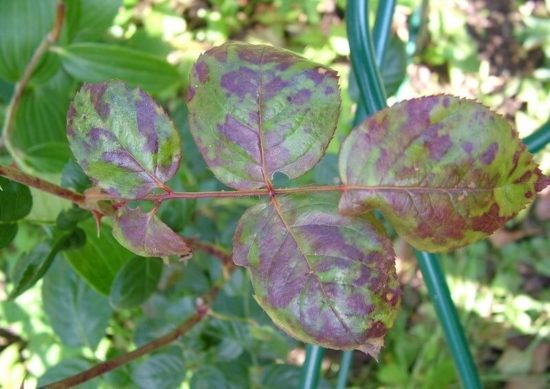
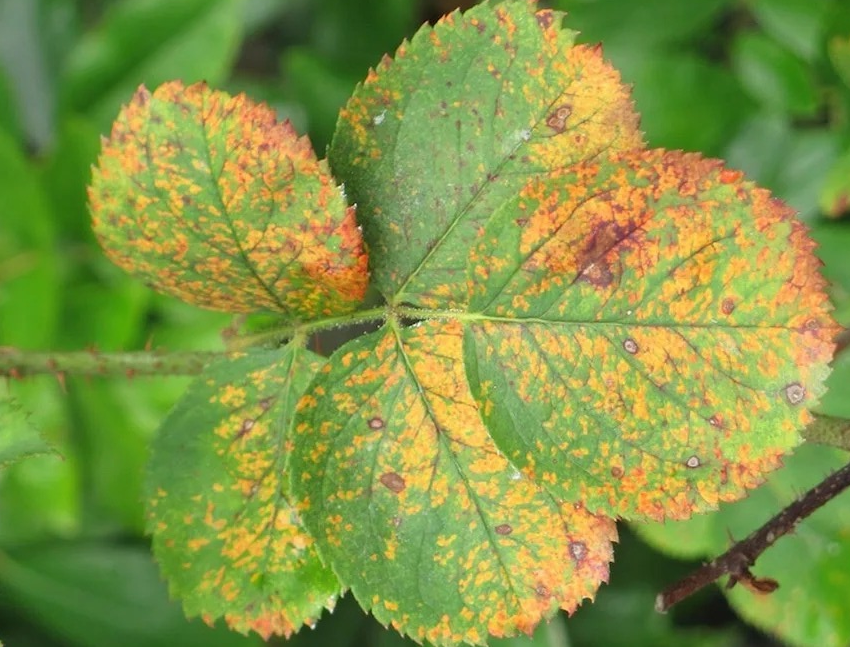
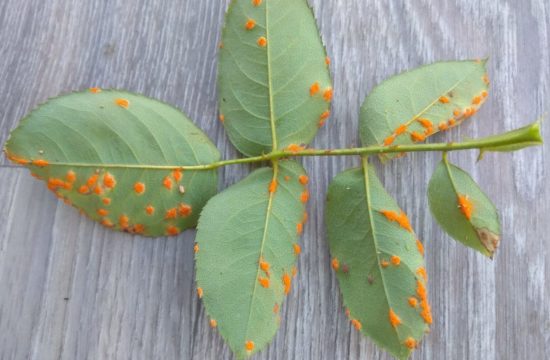
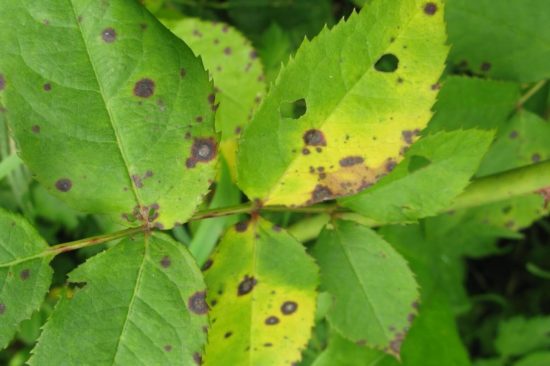
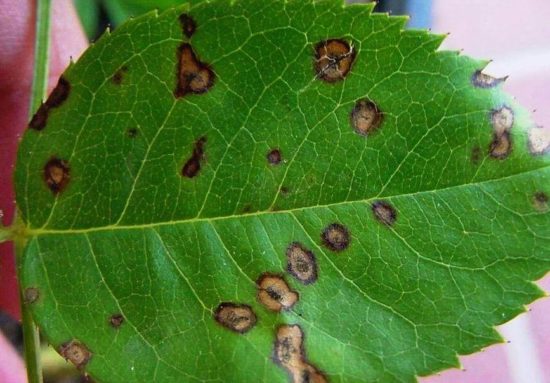

 CUCUMBERS NEVER GET SICK, I'VE BEEN USING ONLY THIS FOR 40 YEARS! I SHARE A SECRET WITH YOU, CUCUMBERS ARE LIKE THE PICTURE!
CUCUMBERS NEVER GET SICK, I'VE BEEN USING ONLY THIS FOR 40 YEARS! I SHARE A SECRET WITH YOU, CUCUMBERS ARE LIKE THE PICTURE! You can dig a bucket of potatoes from each bush. Do you think these are fairy tales? Watch the video
You can dig a bucket of potatoes from each bush. Do you think these are fairy tales? Watch the video
 How our fellow gardeners work in Korea. There is a lot to learn and just fun to watch.
How our fellow gardeners work in Korea. There is a lot to learn and just fun to watch. Eye trainer. The author claims that with daily viewing, vision is restored. They don't charge money for views.
Eye trainer. The author claims that with daily viewing, vision is restored. They don't charge money for views. A 3-ingredient cake recipe in 30 minutes is better than Napoleon. Simple and very tasty.
A 3-ingredient cake recipe in 30 minutes is better than Napoleon. Simple and very tasty. Therapeutic exercises for cervical osteochondrosis. A complete set of exercises.
Therapeutic exercises for cervical osteochondrosis. A complete set of exercises. Which indoor plants match your zodiac sign?
Which indoor plants match your zodiac sign? What about them? Excursion to German dachas.
What about them? Excursion to German dachas.